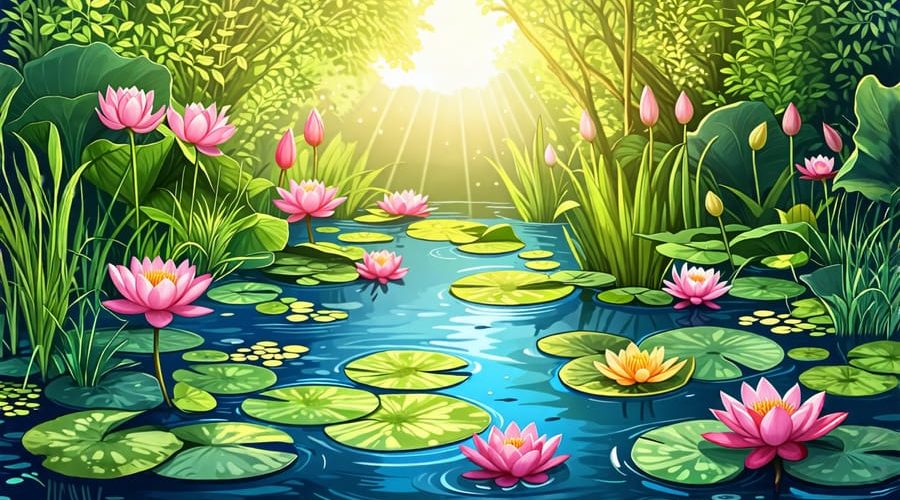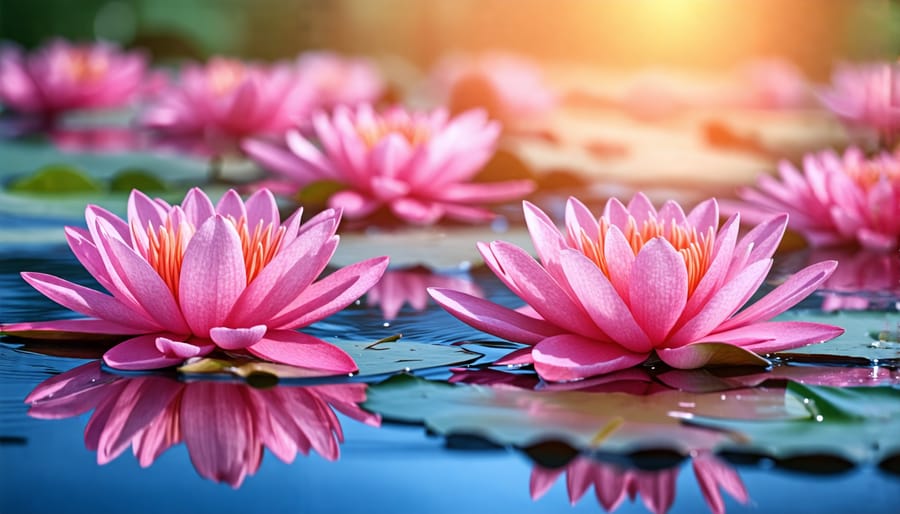
5 Stunning Pond Plants That Thrive Without Soil
Discover the world of soilless pond plants that effortlessly transform your water garden into a lush, thriving oasis. From graceful floating beauties to submerged wonders, these stunning pond plants defy the need for soil, allowing their roots to hang freely in the water while drawing nutrients directly from their aquatic environment. Unleash your creativity as you mix and match species like water lettuce, hornwort, water hyacinth, crystalwort, and duckweed to craft enchanting aquascapes that captivate the eye and support a vibrant ecosystem. Embrace the freedom and versatility of soilless pond plants, and watch as they work their magic, purifying the water, providing shelter for aquatic life, and painting your pond with an ever-changing tapestry of colors and textures. Dive into the world of pond plants that don’t need soil and experience the joy of cultivating a slice of living art right in your own backyard.
Water Lilies: Elegant Floating Beauties
Water lilies are among the most beloved and recognizable pond plants, admired for their stunning blooms that seem to float effortlessly on the water’s surface. These elegant beauties come in a variety of colors, shapes, and sizes, each adding its own unique charm to any aquatic setting. From the classic hardy water lilies to the more exotic tropical varieties, there’s a water lily to suit every pond and preference.
Hardy water lilies are well-suited to cooler climates and can overwinter in the pond, emerging again in spring. They come in a range of colors, from crisp white to soft pink, vibrant yellow, and deep red. Tropical water lilies, on the other hand, thrive in warmer temperatures and boast larger, more vibrantly colored flowers in shades of blue, purple, and even multicolored patterns.
Water lilies spread their round leaves across the water’s surface, providing shade and shelter for fish and other aquatic life. Their leaves also help to minimize algae growth by blocking sunlight from reaching the water. Beneath the surface, water lilies anchor themselves in soil at the bottom of the pond, with long stems connecting the leaves and flowers above.
To care for water lilies, plant them in aquatic containers filled with heavy clay soil and fertilize them regularly during the growing season. Ensure they receive ample sunlight, at least six hours per day, for optimal growth and blooming. Propagate water lilies by dividing their rhizomes in late spring or early summer, allowing you to expand your collection or share with fellow pond enthusiasts.
With their breathtaking flowers and serene floating foliage, water lilies are a must-have for any pond. Whether you choose hardy or tropical varieties, these elegant beauties will undoubtedly enhance the visual appeal of your aquatic oasis, creating a tranquil and inviting atmosphere for all to enjoy.

Lotus: Sacred Symbols of Serenity
The lotus flower holds a revered place in many cultures, cherished for its beauty and deep symbolic meaning. In Buddhism and Hinduism, the lotus represents spiritual enlightenment, purity, and rebirth. Its unique growing cycle embodies the journey of the soul, rising from the murky depths of attachment and desire to blossom in the light of wisdom and compassion.
Lotuses thrive in still, shallow ponds with plenty of space to spread their iconic circular leaves, known as lily pads. These leaves can span several feet in diameter, providing shade and shelter for fish and other aquatic life. The flowers themselves are strikingly beautiful, with layered petals ranging from pristine white to vibrant pinks and purples. Each bloom emerges from the water atop a slender stalk, opening in the morning sun and closing at night.
What makes the lotus truly remarkable is its ability to grow in challenging conditions. The plant takes root in the mud at the bottom of the pond, yet remains untouched by the dirt and debris. As the leaves and flowers rise to the surface, they emerge clean and radiant, pearls of water beading on their surfaces. This resilience and purity amid adversity is central to the lotus’s symbolism.
To create the ideal environment for lotuses, the pond should have still, warm water and plenty of rich soil or clay at the bottom for the tubers to root in. Lotuses are hungry plants and benefit from regular fertilization to fuel their growth. With proper conditions and care, these sacred symbols of serenity can transform a simple backyard pond into a tranquil oasis for reflection and meditation.

Water Hyacinth: Prolific Purple Charmers
Water hyacinth is a captivating floating plant known for its rapid growth and stunning lavender blooms. These vibrant flowers, arranged in spikes, add a delightful pop of color to any pond or water feature. The plant’s glossy, rounded leaves create a lush green carpet on the water’s surface, providing shade and shelter for fish and other aquatic life.
However, pond enthusiasts must exercise caution when introducing water hyacinth to their aquatic gardens. This prolific grower can quickly overtake a pond, doubling in size every two weeks under ideal conditions. Left unchecked, water hyacinth can lead to reduced oxygen levels, harming fish and other pond inhabitants.
To control water hyacinth’s invasiveness, regularly remove excess plants by hand or with a rake. Consider containing the plant within a floating barrier or planting it in submerged baskets to limit its spread. In colder regions, water hyacinth is often treated as an annual, as it cannot survive freezing temperatures.
Despite its potential drawbacks, water hyacinth remains a popular choice for its beauty and ability to absorb excess nutrients from the water. With proper management, this purple charmer can be a delightful addition to your pond, creating a picturesque and tranquil oasis in your backyard.
Hornwort: Submerged Oxygenators
Hornwort is a highly effective submerged oxygenator that can significantly improve the health and clarity of your pond water. As a floating plant, hornwort absorbs nutrients directly from the water column, helping to outcompete algae and maintain balanced water chemistry. Its finely branched stems provide extensive surface area for beneficial bacteria to colonize, further enhancing the pond’s natural filtration processes.
One of the key benefits of hornwort is its ability to oxygenate pond water through photosynthesis. During daylight hours, the plant releases oxygen into the water, creating a healthier environment for fish and other aquatic life. This natural aeration helps to prevent stagnation and reduces the risk of harmful oxygen depletion.
Hornwort is known for its adaptability and resilience, thriving in a wide range of water conditions. It can tolerate varying temperatures, pH levels, and light intensities, making it an ideal choice for both beginner and experienced pond enthusiasts. This versatile plant requires minimal care, as it does not need to be anchored in soil and can simply float freely in the water column.
To maintain the health and vigor of your hornwort, periodically remove any excess growth to prevent overcrowding and maintain good water circulation. With its easy care requirements and impressive oxygenating capabilities, hornwort is an excellent addition to any pond seeking to improve water quality and create a thriving ecosystem.
Duckweed: Mini Greens for Shade and Sustenance
Duckweed is a fast-growing floating plant that can quickly cover the surface of your pond, providing shade and reducing algae growth. These tiny, leafy greens resemble miniature lily pads and come in various species, such as Lemna minor and Wolffia arrhiza. Duckweed is not only aesthetically pleasing but also serves as a nutritious food source for fish and waterfowl.
One of the main benefits of duckweed is its ability to absorb excess nutrients from the water, helping to maintain a healthy pond ecosystem. It also provides shelter for small aquatic creatures and can even be harvested as a protein-rich supplement for animal feed.
However, due to its rapid growth rate, duckweed can quickly become invasive if left unchecked. To prevent it from taking over your pond, consider implementing containment methods such as floating barriers or regularly scooping out excess growth. You can also introduce fish species that feed on duckweed, like koi or tilapia, to help control its spread.
When adding duckweed to your pond, start with a small amount and monitor its growth closely. With proper management, this mini green can add a unique charm to your water garden while providing valuable shade and sustenance for its inhabitants.

Conclusion
Soilless pond plants offer a myriad of benefits and add a unique touch of beauty to any water gardens. From their low-maintenance nature to their ability to purify water naturally, these plants are a fantastic choice for both novice and experienced pond enthusiasts. Whether you’re captivated by the vibrant colors of water lettuce or the delicate beauty of fairy moss, there’s a soilless plant that will perfectly complement your pond’s aesthetic. So why not dive in and explore the wonderful world of soilless pond plants? With a little creativity and care, you can transform your water garden into a serene oasis that will bring you joy for years to come.
